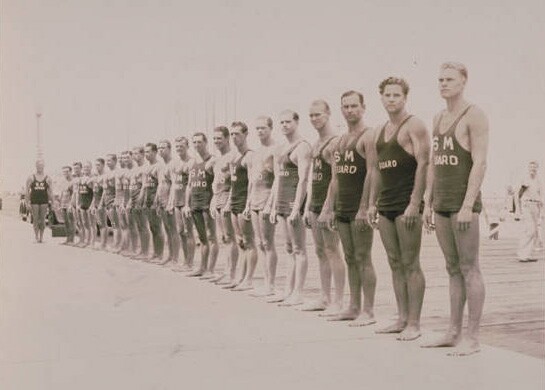Paddleboarding: Southern California's Lost Sport

This Saturday, a sport with deep Southern California roots returns to the Southland with the 2011 Santa Monica Pier Paddleboard Race and Ocean Festival. For decades, paddleboarding—a sport in which participants lie or kneel on a board and propel themselves forward with their hands—shared Southern California's coastal waters with the related sport of surfing before it vanished in the 1960s.
Paddleboarding began as an integral part of surfing. Unlike today's judged surfing competitions that emphasize skilled performance, early contests were organized as races, with surfers beginning on the beach, paddling to a buoy or marker, and then turning around to ride a wave back to a designated point on the shore. Speed in paddling, then, was a prized skill, and some of surfing's early legends were renowned for their paddling abilities in addition to their wave riding talents.
It wasn't until the early 1930s that paddleboarding emerged as a distinct sport. In 1926, legendary surfer Tom Blake—an itinerant who spent much of his time in Southern California—optimized the design of the traditional Hawaiian surf board for swift paddling. Drilling hundreds of holes into a redwood plank and then covering them with a thin layer of wood, Blake reduced the weight of the 15 foot-long board from 150 to 100 pounds.
Two years later, Blake demonstrated the virtues of his semihollow design at the inaugural Pacific Coast Surf Riding Championships, held in Corona del Mar near Newport Beach, by outpaddling his competitors to the buoy. Then, on a then-standard 9'6" wave riding board that he had stacked on his longer paddleboard, Blake returned to shore first to claim the championship trophy.


Blake's design quickly found adopters. As a part-time lifeguard in Santa Monica, Blake popularized the paddleboard as a life-saving device. The Los Angeles Times reported in its July 18, 1931 edition on the first recorded instance of a surf board rescue in Santa Monica:
Lifeguard Uses Surfboard in Rescuing Pair
Enter the surfboard rescue! It was effected here late today before the astonished gaze of thousands of bathers. Healy Kemp and Henry Wise put out from the Santa Monica Beach Club in a skiff. The sea was choppy. Three quarters of a mile off the shore a swell swamped the frail craft and the men found themselves floundering in the water. Tom Blake, municipal lifeguard and reputed world's champion surfboard rider, saw their distress signals and struck out for them aboard his Hawaiian surfboard. He found them clinging to the capsized skiff, took them upon his board, and brought them to safety through the breakers.
In August 1932, Santa Monica lifeguards on paddleboards made headlines again when they rescued an Olympic diver who suffered cramps in the middle of a long swim to an offshore structure.
Later that year, Blake raced fellow Santa Monica lifeguards Preston "Pete" Peterson and Wally Burton from Point Vicente on the Palos Verdes Peninsula to Long Point on Santa Catalina Island, a distance of 26 nautical miles. All three used paddleboards based on Blake's design for the race, which was organized in part to promote the board's use among lifeguards. With a fishing boat as an escort, the three surfers left the mainland at 4:05 in the morning. Only five minutes and fifty-three minutes later, an exhausted Blake arrived first on Catalina.



The marathon race spawned the creation of local paddleboard clubs and inspired similar events over the succeeding decades. In 1936, the Western Paddleboard Association organized a relay race from Catalina to the Santa Monica breakwater (since removed) in which members of the Palos Verdes Surfing Club, the San Pedro Swimming Club, and the Santa Monica Paddleboard Club traded fifteen-minute shifts on a single board.
From 1955 to 1960, paddleboarders competed in the annual 32-mile International Paddleboard Race from Catalina to the Manhattan Beach Pier, a marathon contest inspired by the classic 1932 race.
Shorter contests, similar to this weekend's event, were also common. In the 1950s, paddleboarders raced one mile from the Santa Monica Pier to Ocean Park's erstwhile pier in an annual rough-water competition. The photographs below from the USC Digital Library's Los Angeles Examiner Collection show the 1954 race.


In the 1950s and 1960s, paddleboarding declined as a sport while surfing surged in popularity. Some lifeguards continued to use the long paddleboards in their work, but organized races disappeared from California's coastal waters. The Catalina to Manhattan Beach contest briefly returned in the 1980s as the Catalina Classic before receding again into history.
Over the past decade, stand-up paddlesurfing has brought the long paddleboards back to Southern California's shores. A variant of paddleboarding in which surfers stand on their board and use a long paddle for propulsion, stand-up paddlesurfing arrived in Southern California in 2000 and is now a common sight around the region's beaches and marinas.
At this Saturday's Santa Monica Pier event, the past and present come together, with separate divisions for both stand-up paddlers and classic, prone paddleboarders. A temporary "museum for the day" on the pier itself will also highlight the sport's long heritage and the conquests of legends like Blake and Peterson, who achieved near-superhuman feats of strength and endurance off Southern California's shores.

Many of the archives who contributed the above images are members of L.A. as Subject, an association of more than 230 libraries, museums, official archives, personal collections, and other institutions. Hosted by the USC Libraries, L.A. as Subject is dedicated to preserving and telling the sometimes-hidden stories and histories of the Los Angeles region. Our posts here will provide a view into the archives of individuals and cultural institutions whose collections inform the great narrative—in all its complex facets—of Southern California.